As the Director of Sales Development at Drift, I believe that half the value of my team comes from their potential as future sellers.
Sales development reps (SDRs) are typically at the start of their careers. They’re excited to learn and heavily involved in your business. Still, being an SDR is tough, and it can be hard for them to stay motivated or find time to pursue their passions.
Today, I’m talking about my favorite part of my job at Drift — creating career paths that excite and motivate an SDR team. Below, I’ve laid out a step-by-step guide on how to do this with insights from fellow sales development leaders, including:
- John Swartz, Senior Manager of Corporate Sales Development at Workday
- Mo Moran, Senior Director of Sales Development at Greenhouse Software
- Brian Vital, VP of Sales Development at ZoomInfo
Here is how you can shape your SDRs into your company’s future sellers.
We discussed SDR career paths as part of our SDR Leader Series. If you want to watch the full presentation, click here. (While you’re there, check out our other sessions on hiring a successful SDR team and growing SDRs into future sellers.) Otherwise, keep reading for all the insights💡
Our Guide to Building an SDR Career Path That Works
I can’t stress how important it is to build a way forward for your SDRs. Of course, it feels good to show progress. But the real reason is that it gives SDRs a greater sense of purpose.
Early on, SDRs do the same thing every day: dial, dial, dial. With structured career ladders and pathways, your reps are aware of and can work towards the next step in their career.
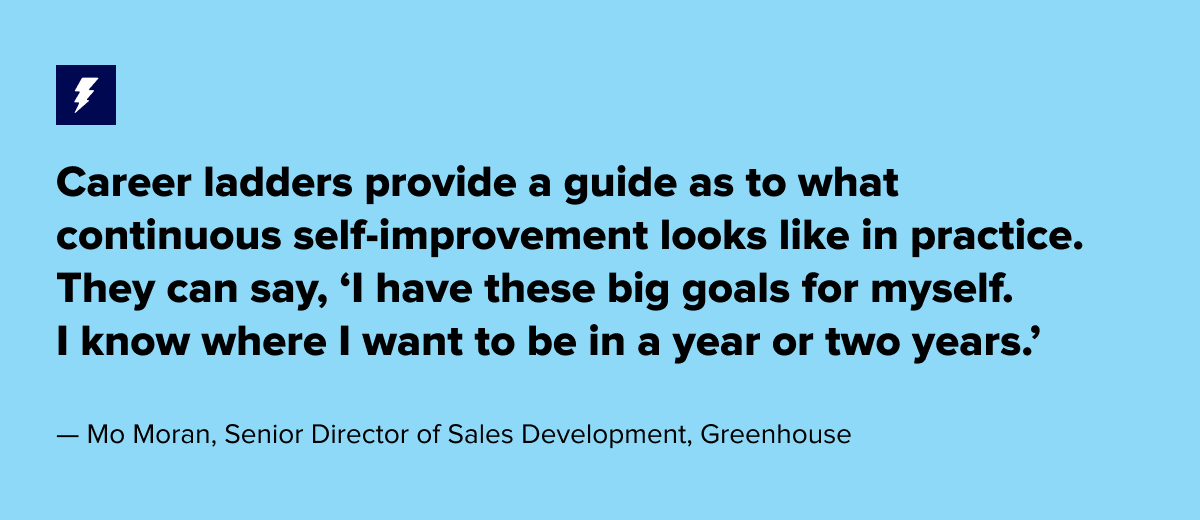
As you design your own career paths, think of ways to break them down into different levels so your SDRs can map their progress. Also, focus on assessing the most important skills. Here are three to keep in mind:
- Consistent performance and quota attainment.
- Softer skills like time management, professionalism, organization, being team-oriented, and having a good attitude.
- Mentorship of other SDRs and proving mastery over key concepts.
Remember: You’re already looking for ambitious hires — so make sure they have somewhere to run to. Here are the six steps to creating an SDR career path that will fuel your team’s fire 🔥
1. Implement a Two-Pronged Structure for Career Growth
So, you’ve hired your rock star SDRs. But this is only their first stop on the path towards career (and company) success. At Drift, we have two different components to career advancement: ladders and pathways.
The ladder is all the steps your reps take to progress in their career within the SDR team.
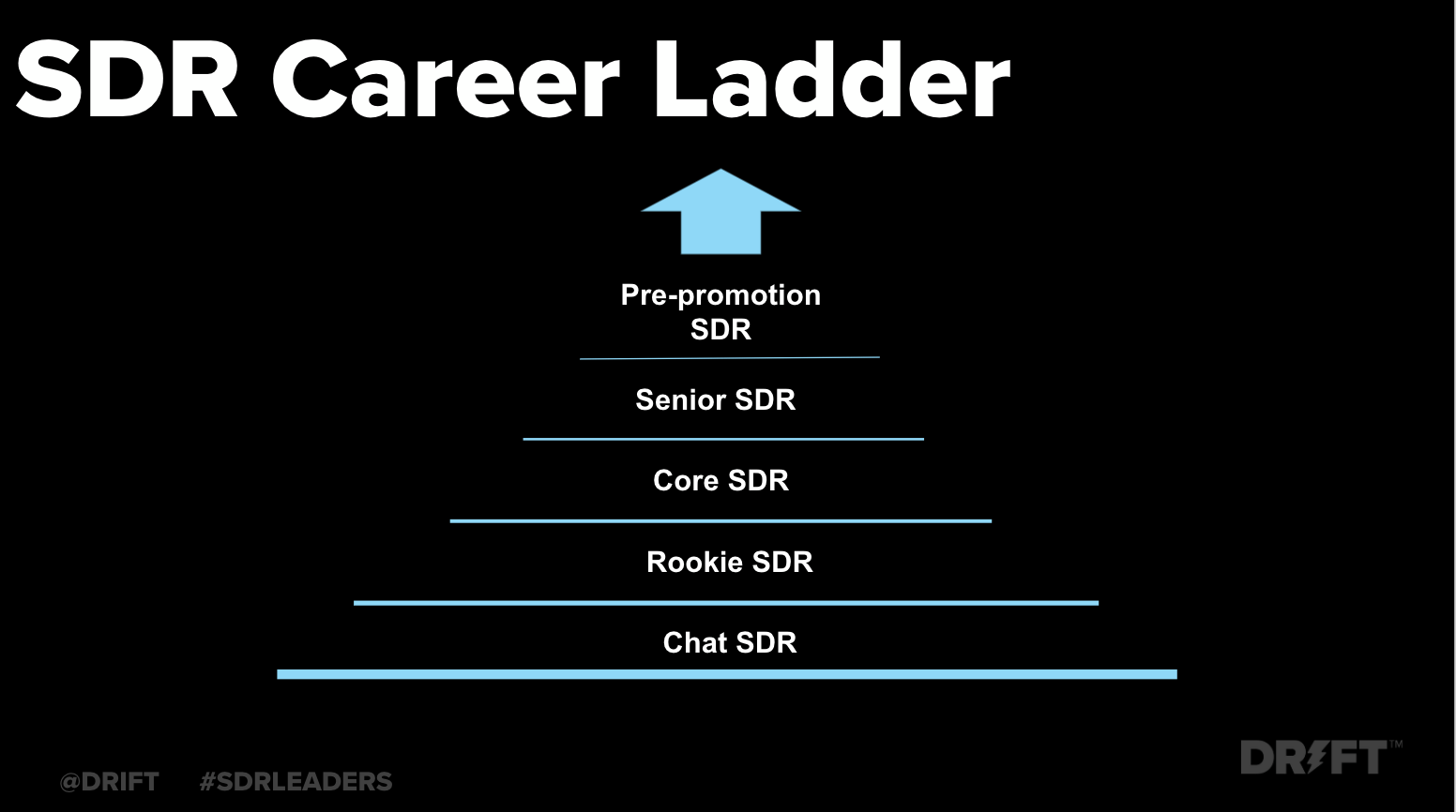
We start most of our SDRs in a chat position. This is something we developed in response to the pandemic because it was challenging to remotely onboard new hires with new technology. When reps start in the chat position, they can quickly gain an understanding of the challenges we solve, the personas we serve, and the solution we provide in a lower-pressure environment.
From there, our reps are promoted to Rookie SDRs where they expand their channels of communication to include phone, email, and LinkedIn. Here, reps get a good grasp of the buyer personas, competitive landscape, workflow, and time management.
Once they reach their ramping quota, we move them into a Core SDR role. That’s where the majority of my team is right now. Here, the goal is to hit four months with 100% attainment. Then, they will be eligible for promotion to Senior SDR — climbing the ladder, as well as earning a pay bump.
Senior SDRs take on more responsibility and build up their internal resume to reach the Pre-promotion SDR position. At that point, they’ll enter a bridge program that is tailored to their chosen career path.
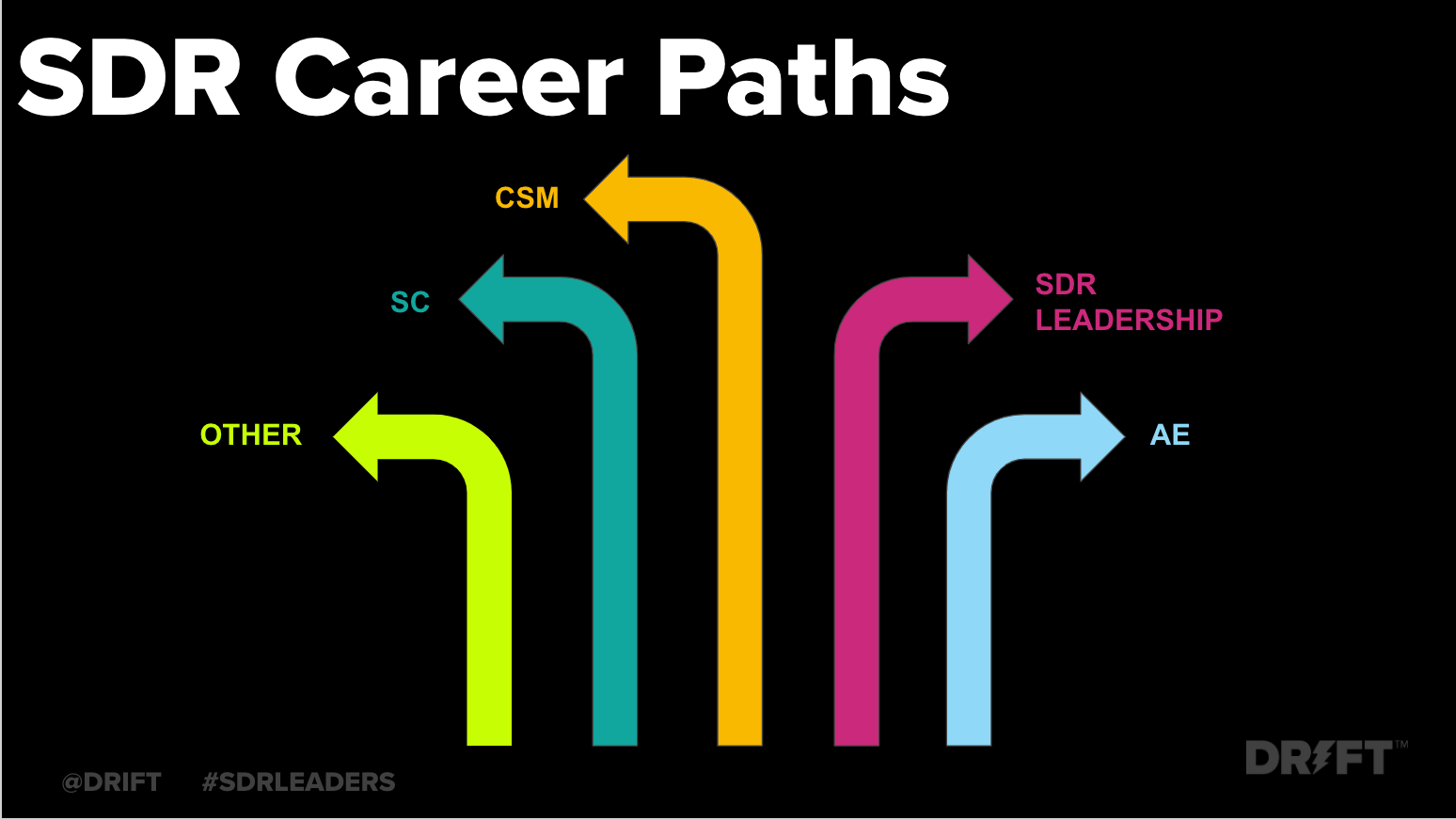
Career paths are all about what comes next. Many SDRs become account executives (AEs) or move into a leadership role within the SDR team. But there are many other possibilities, such as becoming a customer success manager, doing solutions consulting, or jumping into other teams like marketing and operations.
Ultimately, the path your SDR takes will depend on how their strengths and skills align with business needs.
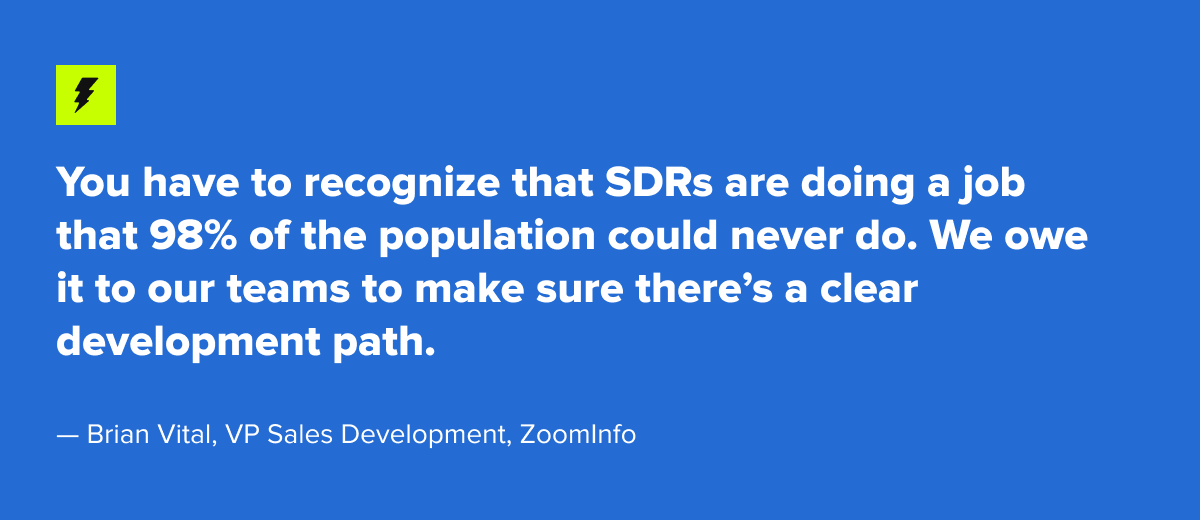
We SDR leaders have to create a path forward so that our teams know they have options for their career — whether that’s six months, a year, or five years from now.
2. Be Upfront About the Timeline
Just because you offer a lot of micro-promotions doesn’t mean moving up the ladder is quick (or guaranteed). Set the expectation up-front that tenure is one of the biggest considerations when it comes to promotions. It will happen when they’re ready.
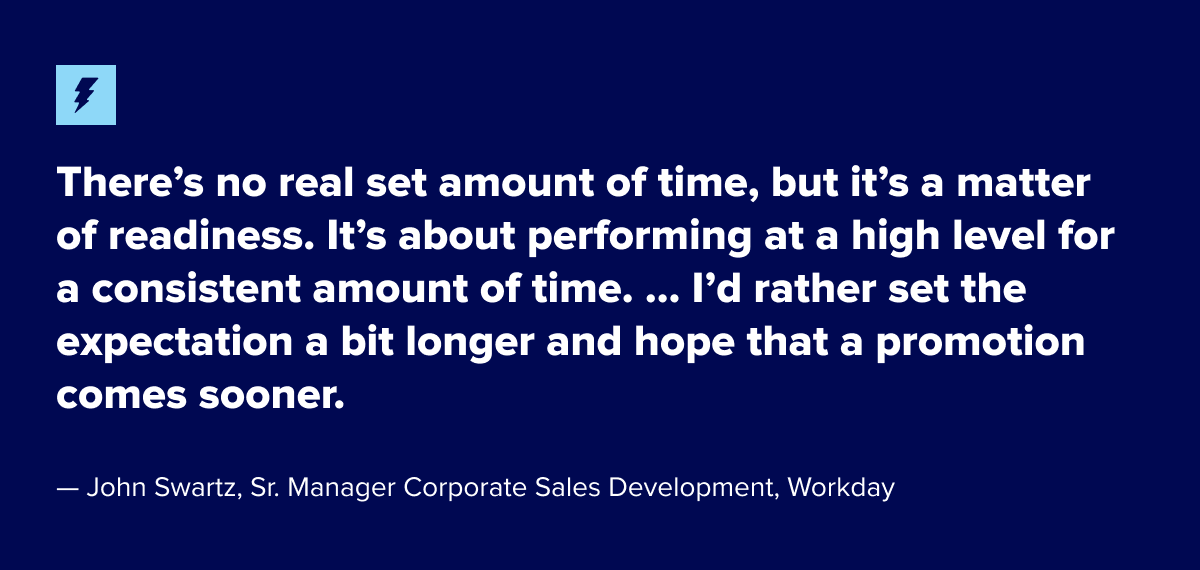
Quantifying readiness is difficult, so the best thing to do is to talk to your team about how tenure impacts ability. The Bridge Group has shown that the post-promotion failure rate for SDRs with 11 or fewer months of experience was 55%. But for SDRs with over 16 months of experience, the failure rate was only 6%.
We know that often a position will click only after time has passed. By then, your reps will have gained the perspective and knowledge to truly thrive in their role. Be clear that readiness isn’t only about feeling ready. It’s also about having the experience to back it up. And that takes time.
3. Meet Regularly to Check in on Career Plans
As a leader, you have to be aware that, while an SDR may have their eye on a specific career path, it may not align with your business needs. To stay in the know, set up a biweekly or monthly meeting with each of your SDRs to talk only about career goals.
Here, the key is to have a regular conversation. What do they love and not love about their current role? What are they interested in? Do they want a job with a quota? Check in on their plans, help them meet other people, recommend training, and brainstorm next steps.
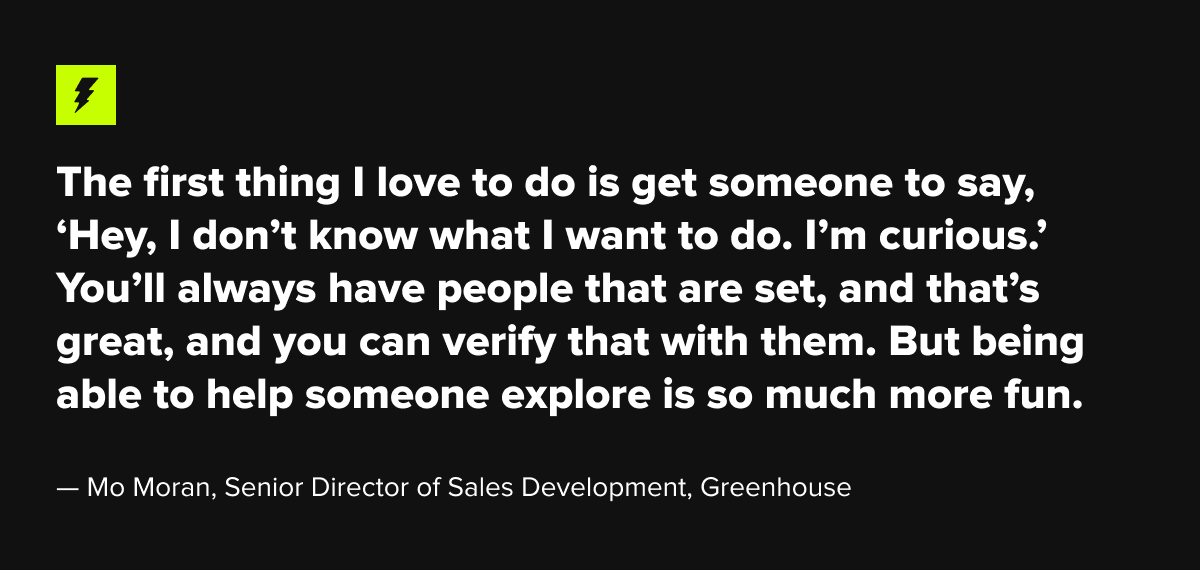
Every SDR has to take ownership of their career. But that doesn’t mean you can’t help them along. Encourage your reps to test out new things and see what resonates with them. We all know that they won’t be an SDR forever — so the more exposure they have to different areas of the business, the more empowered they’ll be.
4. Guide SDRs to the Role That Is Best for Them
Raise your hand if you’ve had an SDR come to you and say, “I really want to be a manager.” And your first thought was, “Not in a million years. But this person would make a great CSM.”
Part of your job as an SDR leader is guiding your team to where they’ll be the most successful…which may not be the role they’re thinking of.
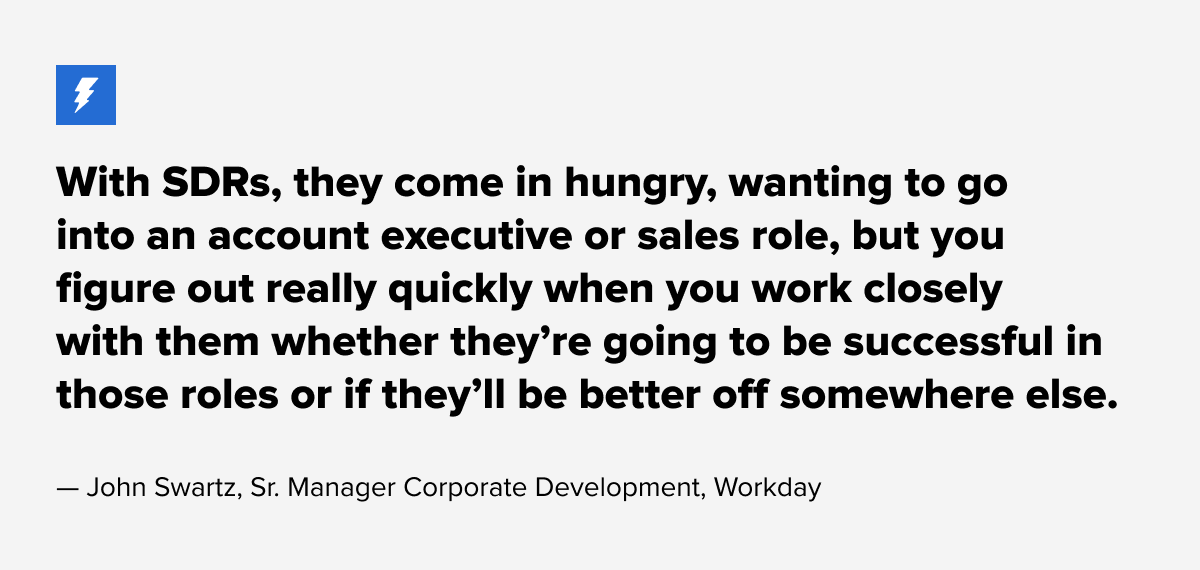
SDRs are typically early in their sales career so it’s your job to educate them on the different sales roles within the organization and see where their strengths and motivations will fit best. Work with leaders across departments to figure out whether they can offer a career path to SDRs and what that would entail.
At Drift, we do a series as part of our training program called the SDR Career Fair. We bring in leaders from different departments, including marketing, sales, operations, customer success, and professional services to talk about what they do and how that fits into the broader goals of the sales organization.
Introducing SDRs to different parts of the business opens up new paths they may not have thought of before. (Plus, it helps them do their jobs more effectively since they have a better idea of who they need to work with.) Your SDRs will naturally gravitate towards different paths based on their skill set, personality, and ability. All you need to do is give them a good push.
5. Emphasize the Cons, Just as Much as the Pros
I’ve heard SDRs say, “My work is done when I become an account executive.” Once they reach the end of that ladder, SDRs feel like they’ve completed the race. But actually, they’re just getting started.
That’s why it’s important for SDRs to see the tough aspects of the different roles available to them — so, when they do get there, they’re prepared for the challenges they might face.
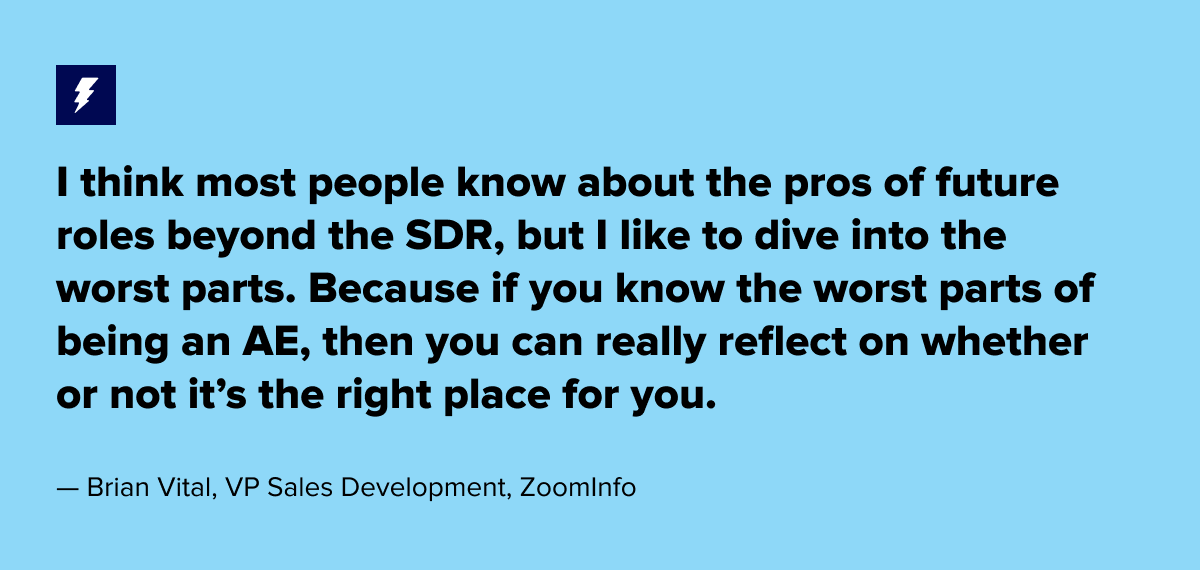
Guiding your team is just as much about figuring out what your SDRs don’t want to do as it is about what they do. Find something small for your SDR to participate in so they can get a feel for the role. This could be a recurring meeting, job shadow, or small project.
If your SDR is still excited about the role after they’ve seen its challenges, then you will know that they’ve hit on the right path.
6. Connect Your Team to the Right Mentors
One of the best ways to prepare your SDRs for their future careers is to introduce them to good mentors. Put a mentorship program in place that matches SDRs based on where the rep is on the career ladder and their chosen career path.
Offer mentorship as soon as possible — as early as onboarding. If you give your reps a senior mentor or cross-functional partner early on in the process, they will feel much more comfortable about future options.
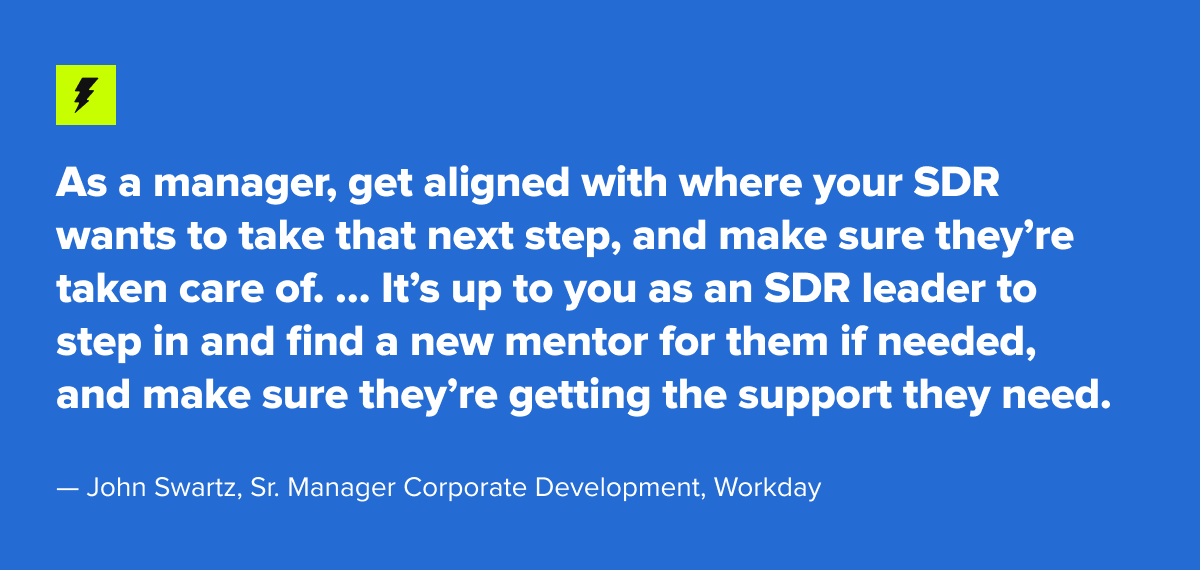
Mentoring your SDRs can mean any number of things. You may want to forge a stronger connection between your SDRs and AEs to ease the transition between those roles. Or, you can sign reps onto cross-functional projects so they can meet teams outside of sales. In the end, your job is to respond to your reps’ interests and help them get what they need.
An SDR’s Career Path Is Not a One Size Fits All
When a person chooses to become an SDR, they are probably only thinking about a future in sales.
While that is one option, there are so many other opportunities that an SDR can take advantage of — in sales operations, analytics, marketing, customer success, etc. As an SDR leader, you want to show your team that all of these avenues are open to them.
Keep these six steps in mind when you’re building out the structure of your SDR team. Once you have a clear path in place, you’ll get to do the awesome job of promoting hard-working and talented SDRs into the role that is truly right for them.









